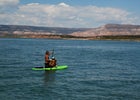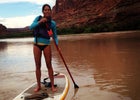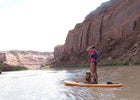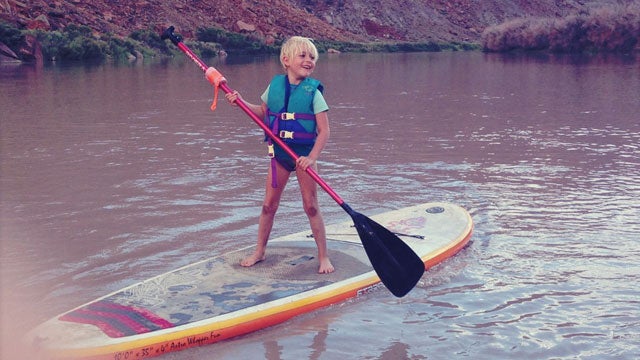My daughters have been angling for their own iPad for months now. But in the interest of promoting outdoor time over screen time, we’re holding off on all things I-related.
 Floating on the Imagine Surfer
Floating on the Imagine Surfer

Except, that is, for an ISUP.
We’ve coveted inflatable stand-up paddleboards for years now. Each spring we take a family raft trip on Utah’s San Juan River with family friends from Durango. Their kids are older than ours, and for the past few years they’ve brought along two or three inflatable paddle boards.
When fully inflated to 15-20 pounds per square inch, the rubber boards feel as rigid as plastic. But unlike their hardshell brothers, ISUPs bounce off obstacles and don’t break or dent when you ram into rocks, which makes them ideal for whitewater. Deflated, they fit into large nylon bags—perfect for traveling. They’re stable enough to carry small children, and by eight or nine, our friends’ kids were old enough to paddle them solo through easy Class I rapids.
This spring, we realized our girls were finally big enough to become SUP passengers. One July weekend at our family’s lake cottage in Ontario, I rented a fiberglass , from Vancouver-based , at the water sports shop on the mainland. Its sleek hull—basically a durable, lightweight sandwich of epoxy glass and foam—cut crisply through the flat water with admirable efficiency. I could feel the lake rising up to meet me through the soles of my bare feet. I loved the board’s simplicity, the ease of standing upright, the balance required to respond to the shifting waves. I was walking on water.
I took the Big out on a gusty day and paddled straight into the chop. The board and I streaked along, circumnavigating half a dozen islands. Back at the cottage, the wind abated and I loaded up one daughter at a time and zigzagged across the channel. I traded places with five-year-old Pippa, and let her take over. She shortened her grip on the long paddle, and pretty soon we were gliding smoothly around our little bay.
Even my stepfather got in on the action, launching the 11-foot board straight off the dock with barely a wobble. My 72-year-old mother, who’d recently torn her hamstring playing tennis, wanted in, too. She would have waltzed right off the dock onto the board if prudence hadn’t intervened.
Just like that, we were addicted.
Landlocked again in New Mexico, I was desperate to figure out a way to paddle and swim, solo or with my girls, before the summer ran out. My ancient Dagger whitewater kayak still hangs in our carport, but I haven’t paddled it since before my daughters were born, plus there’s no room for little ones to ride along. Our canoe is too heavy for me to lift on and off the car roof by myself, and our raft is too cumbersome for quick day trips.
So I borrowed a friend’s plastic Imagine Surf’s for a couple of day trips to a nearby lake. At 47 pounds and made from blow-molded polyethylene (it feels just like a whitewater kayak), the board was bomber with both girls aboard (it’s buoyant to 310 pounds), but an absolute bear to carry. Our local whitewater shop sells Surfers, which at about $600, are among the most affordable SUPs available, but I knew I wanted the freedom of a board I could sling on and off the car without help. And so the search continued.
Then on a last gasp, 36-hour solo adventure��to Colorado, I rented two boards from Buena Vista’s . The shop has a huge demo fleet of inflatable and plastic SUPs for running whitewater, doing SUP yoga, surfing waves, and touring lakes. I wanted a light, portable, inflatable SUP that could withstand the extra weight of a couple little girls but not be a dog on the flat water—a tricky proposition since ISUPs always sacrifice a little speed and efficiency for stability and durability.
I rented a sleek, polyethylene with a foam core and a sticky, stern-to-bow rubber mat made for yoga and a 10-foot . On a lake north of town, I paddled both in stiff winds. No question the Bic cut through the water with grace; I liked the slap of waves against the hull—it reminded me of a sailboat beating across the wind, fast and nimble. I pictured building my personal quiver of boards in our carport back home, with the 35-pound Bic my weapon for speed.
But then I launched the Starboard, so light I could lift it off the roof with one hand and, at nearly three feet wide, roomy enough for a pair of little ones. It didn’t hew to such a hard, straight, fast line as the Bic, but nor did it feel slow and sloppy. I knew that if I wanted a board that could do it all—flat water and rapids, with kids and solo—the Starboard was the one.
A couple weeks later, we left for a family flat water trip on the Green River, north of Moab. I’d liked the Starboard Whopper so much I bought one of my own, and during the next four days, I paddled it 45 miles downstream through water the color and consistency of a mocha milkshake. My Whopper is four inches thick, with a buoyancy of 200 pounds, and I worried for a minute that I should have opted for the six-inch, fatter board to accommodate a fleet of growing girls. But when my daughters climbed aboard, along with their friend, the Whopper rode steady and proud, without a hint of sag.
When afternoon thunderstorms blew in, we tied the Whopper to the raft with a strap until the worst blew over, and then the girls climbed aboard and practiced paddling while we towed them on a short leash. Elastic straps in the front secured a water bottle and errant hats; the only thing I wished for was a D-ring in the bow for easier tethering.
Mostly, though, I paddled solo—the solitude a delicious, long-awaited reward for five years of holding squirmy babies on my lap during wilderness river rafting trips. At first, I didn’t know what to do with my freedom, looping back to the raft every few minutes to tempt the girls with a ride. But quickly I realized what a gift it was, and I slid away from the group and into the silence and stood high on my board and watched the canyon walls drift by. The river was so placid that sometimes I’d lie on my board and look up at the sky. I even managed to maneuver a couple downward dogs without going head first into the river.
By the time we got to the takeout, four days later, my board and I had practically become one—we were both filthy and plastered with mud. But alone and under my own power on the river for the first time in years, I’d shed my mama skin for a little while and was simply me.
A week later, on the last day of summer, I took the girls to Abiquiú Lake, north of Santa Fe, to see how the still-inflated Whopper performed on flat water (you can leave ISUPs inflated all summer, or even all year). As soon as we launched, I could feel a slight flex in the board, as though it needed more air. More likely, though, it was simply registering to 180 pounds of accumulated girl weight, and without a current to help us along, it felt more sluggish than it had on the river.
Still, we floated into the lake, the girls jumping ship between my Whopper and my friend’s rented board. The sky was clear and blue, but in a few days the weather would turn crisp and cool. I was glad for one last day on the water with my girls. It was the end of summer but the start of our life with ISUPs.
��
Big by Kahuna Paddleboards; $1599;
Surfer by Imagine Surf; $599;
Dura-Tec by Bic; $800;
Astro Whopper Fun by Starboard; $1099;


